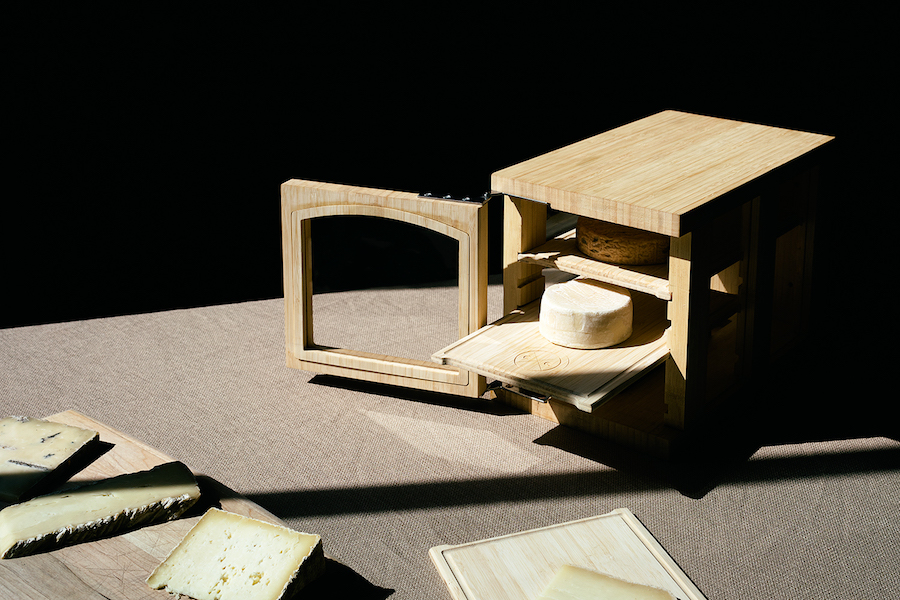It’s the age-old cheese keeper’s dilemma: Without a cave of one’s own, how to keep fresh a block of brie or wedge of bleu? Wrapping it in wax paper and storing it in the vegetable drawer, using cheese paper or Tupperware, tucking it away in plastic wrap—these are all makeshift solutions.
Jessica Sennett was determined to solve this problem when she conceptualized Cheese Grotto, a patent-pending storage device that mimics one of the oldest, crudest aging implements: the cheese cave itself.
Sennett was initially struck with the idea after leaving her cheese educator role at Bedford Cheese Shop to go back to school. For years, proper cheese storage had been a concern for her students and customers, but it was in her classes at The New School that Sennett was finally given the opportunity to let the concept of a scalable, at-home cheese cave fully blossom.
What is it about the caves of yore that’s so conducive to making and storing excellent cheeses? It comes down to temperature, humidity and ventilation. According to Sennett, optimal humidity is between 85 and 90% when aging fresh wheels of cheese, and around 75% for simply keeping it smartly stored. Each grotto is equipped with a dual-purpose thermometer hygrometer for gauging this, and she says popping in to visit your cheeses once a day is fine.
The most up-to-date Cheese Grotto prototype is a vaulted box made of breathable bamboo, designed to be small enough to fit inside the home refrigerator, though it also works on the counter. It has three removable trays that double as stylish cutting boards and serving platters. Each level comes with its own adjustable sliding air flow controls to accommodate the needs of a few different varieties at once, allowing the cheese to breathe.
Each level comes with its own adjustable sliding air flow controls to accommodate the needs of a few different varieties at once, allowing the cheese to breathe.
The Grotto’s vaulted ceiling simulates its ancient ancestor, naturally controlling condensation buildup so moisture isn’t trapped inside—and keeping it wicked to the side, so it doesn’t fall on the cheese. The original humidor was made of granite, which was ultimately deemed too dense; one made of clay now lives underneath the bottom tray.
This clay version is a familiar element in some cheesemaking processes, and has just the right absorption properties to both hold the water and slowly release it. Still to come: an electronic cooling fan that will attach to the back of the box, as the cheeses respond to a cooler temperature.
A self-proclaimed homesteader herself, Sennett intends for the Grotto to appeal to both the home cheesemaker and general cheese enthusiast. While operating the Grotto is not an intimidating or overly intensive process for novice turophiles to learn—weekly humidor submerge, monitor temperature, adjust airflow accordingly, voilà!—the design is still advanced enough to enable more diehard DIY cheesemakers to do their thing.
Sennett stumbled into cheesemaking through a part-time job as a cheesemonger at Cowgirl Creamery in the San Francisco Bay Area, where she grew up. She hadn’t intended to make a vocation of it, but found the minutiae of working with food and the nuances of cheese production to be a “grounding thing.”
“I really like that I get to use the right and left brain,” she says. “It’s art and science combined.”
Her days have become very different, what with running a startup and worrying about Cheese Grotto production and design (there are currently five prototypes, all scattered throughout her home in Sunset Park), finding the right people to manufacture the device (she hopes to source all American-made materials), seeking investors and getting the word out. Still, Sennett feels unfazed by the shift from food production and education to becoming president and founder of Cheese Grotto.
While operating the Grotto is not an intimidating or overly intensive process for novice turophiles to learn, the design is still advanced enough to enable more diehard DIY cheesemakers to do their thing.
Currently in testing, the Cheese Grotto has already been found to give cheese stored in it four times longer shelf life than cheese wrapped in plastic wrap and refrigerated, and three times longer than cheese stored in cheese paper or Tupperware. The Cheese Grotto is expected to officially launch later this year for use in the home, with eventual plans to expand into commercial sales.
There’s nothing quite like Sennett’s device on the market today, so dairy aficionados take note: The Cheese Grotto gives you back your control as a guardian of Gouda, an aspiring Swiss savant. Freed from having to worry about their cheese going moldy, cheese lovers are free to concern themselves with less dismal plans—like which wines to pair with.



